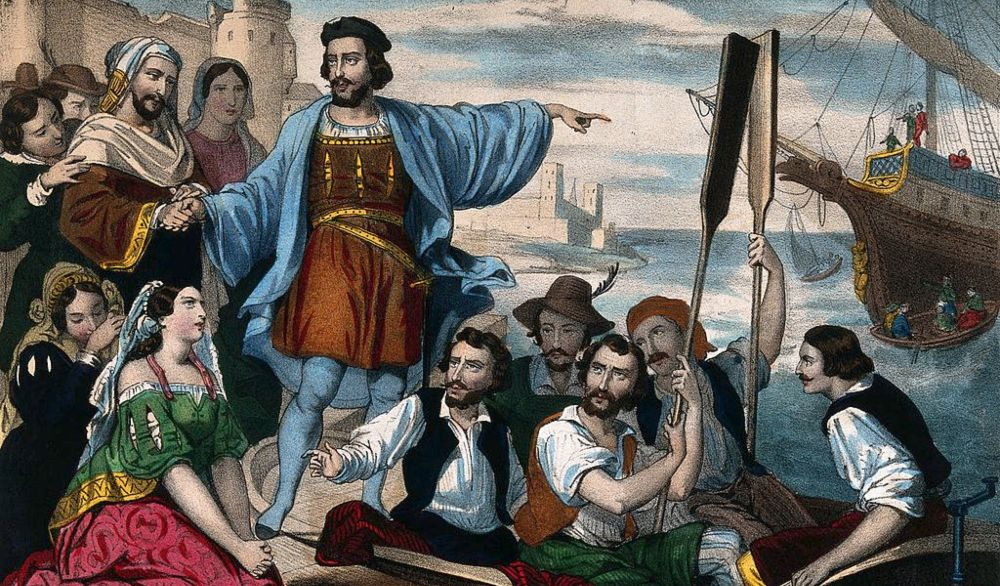From Genoa, Italy to Washington State, U.S.A. – and a thousand stops in between – the name Columbus identifies towns, schools, streets, rivers, playgrounds, and more sites across North America. In the Pacific Northwest the explorer’s name was re-shaped to accommodate our region’s great path-to-the-sea: the Columbia River.
Common usage of the name Columbus has blurred the life and accomplishments of an individual whose life was full, controversial, and epochal. The Columbia River, roaring, seeping and falling across western Canada and the United States, is more than a water source. It is a sculptor of soil and rock, a unique tourist attraction and a meandering highway. It holds a story: the life of a man and his time.
In 1953, the world, and especially North America, celebrated the 500th anniversary of Christopher Columbus’ “discovery” of the North American continent. Indigenous people were established and powerful in the America at that time, and other great civilizations had previously arisen and disappeared. But because our river and Far Corner were late to these great events, it’s appropriate to take a closer look at Columbus the person.
Several years ago, two influential artistic and historical events came on the scene. First was a film called “1492: Conquest of Paradise,” starring French actor Gerard Depardieu and directed by American Ridley Scott. Second was publication of Admiral of the Ocean Sea, the Pulitzer Prize-winning biography of Christopher Columbus by Samuel Eliot Morison.
What did Christopher Columbus look like? Morison tracked down descriptions of him, as did researchers for the film. In physical appearance he was taller than the average man of his era. Most contemporary observers wrote that he was red-headed, ruddy-complexioned, blue-eyed, and had high cheekbones.
Columbus’ son Ferdinand noted that his father’s hair turned white by age 30. Ferdinand also described his father’s strict religiosity – Roman Catholic of course. Las Casas, the first Catholic priest to be ordained in the New World, and who knew the Admiral in Hispaniola (today’s Dominican Republic) in 1500, offers similar statements, adding that he was “affable” in general conversation, but could be forceful in negotiation. Las Casas also observed that Columbus was intent on teaching local Natives the Christian faith.
Columbus’ family tree has modest origins, as author Morison writes, from “fifteen or twenty notarial records and municipal documents.” It seems clear, according to Morison, that Columbus came from illiterate Genovese stock, mostly weavers, clothiers, and cheese mongers. His name was likely taken from the story of St. Christopher, familiar to every child in the Middle Ages. The fact that he was raised a strict Catholic, and carried the name of the saint of travelers, might have been more than coincidental to his future.
Although Morison does not accept the possibility that Columbus may have come from Jewish antecedents, he nevertheless speculates on the matter. Columbus certainly knew of the Spanish and Portuguese laws expelling Jews from the Iberian Peninsula, which were promulgated during his time. Also, as an ambitious and intelligent man, Columbus was aware that his professional hopes relied on showing an obvious and unwavering fealty toward the dominant Roman Catholic faith.
Tyrannical methods to subjugate aboriginal peoples were introduced by Columbus’ men, and many who followed, and these outrages were rationalized by cries of “saving” ignorant heathens. If political terror was invented by anyone, it was likely the founders and implementers of the Spanish Inquisition.
In some ways, Columbus’s life suggests a permanent connection to North America, including the Pacific Northwest. Despite his humble origins, he succeeded as a professional sailor, negotiator, and commander. He may have been a member of a persecuted race – a Jew – in a time when death or expulsion for that circumstance could have been his reward. He was a pioneer, the first to cross an endless sea that had defied and frightened scores of brave and well-educated men before him. Lastly, his skill as a navigator was without peer.
Biographer Morison, himself an experienced sailor (an Admiral), wrote that Christopher Columbus “proved to be the greatest navigator of his age, and enabled him to train . . . captains and pilots . . . who would explore the world for decades thereafter.” It’s not surprising that the name Columbus emerges in the Pacific Northwest in many forms, including the winding, nurturing, beautiful Columbia River.
Discover more from Post Alley
Subscribe to get the latest posts sent to your email.
